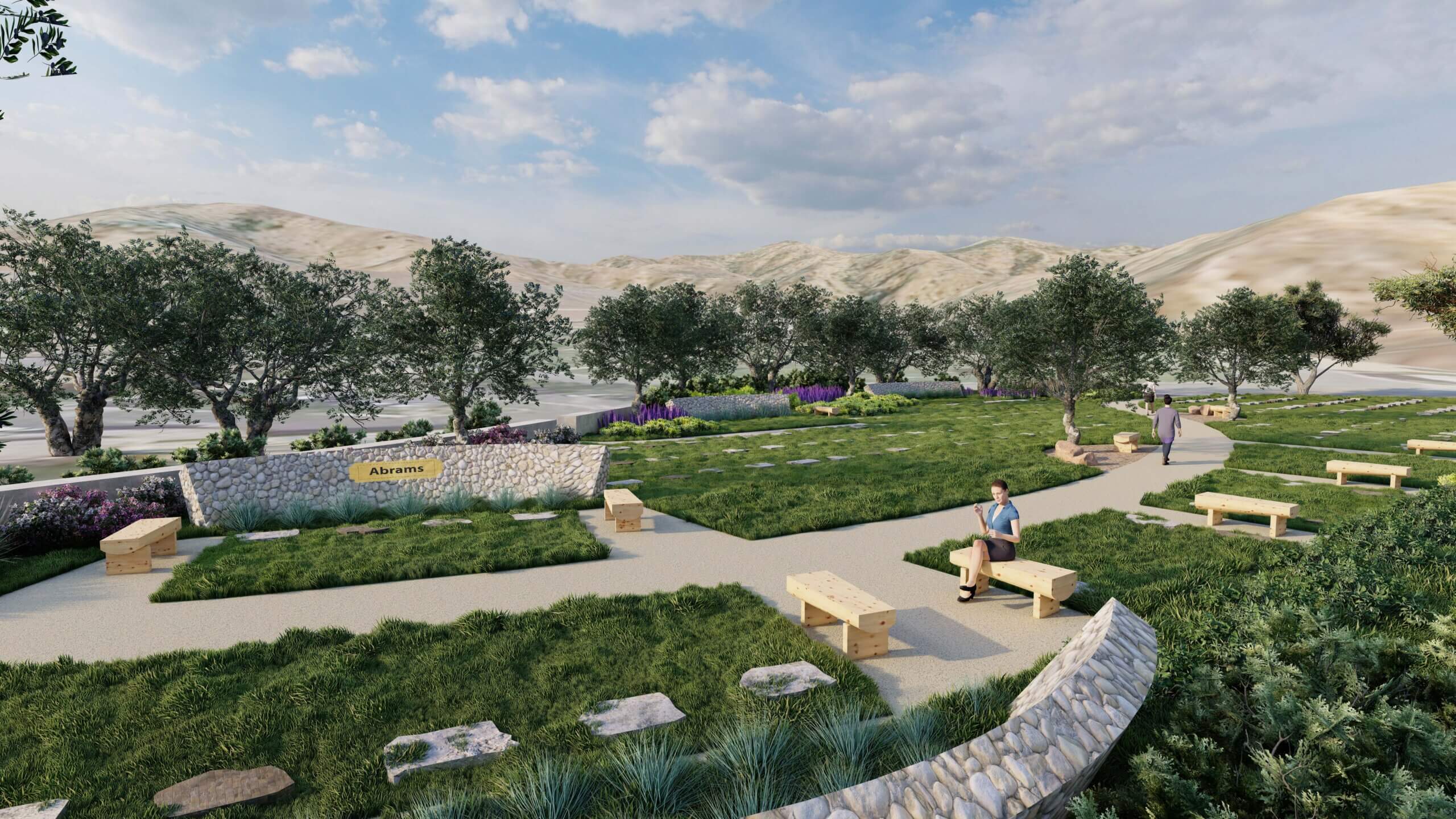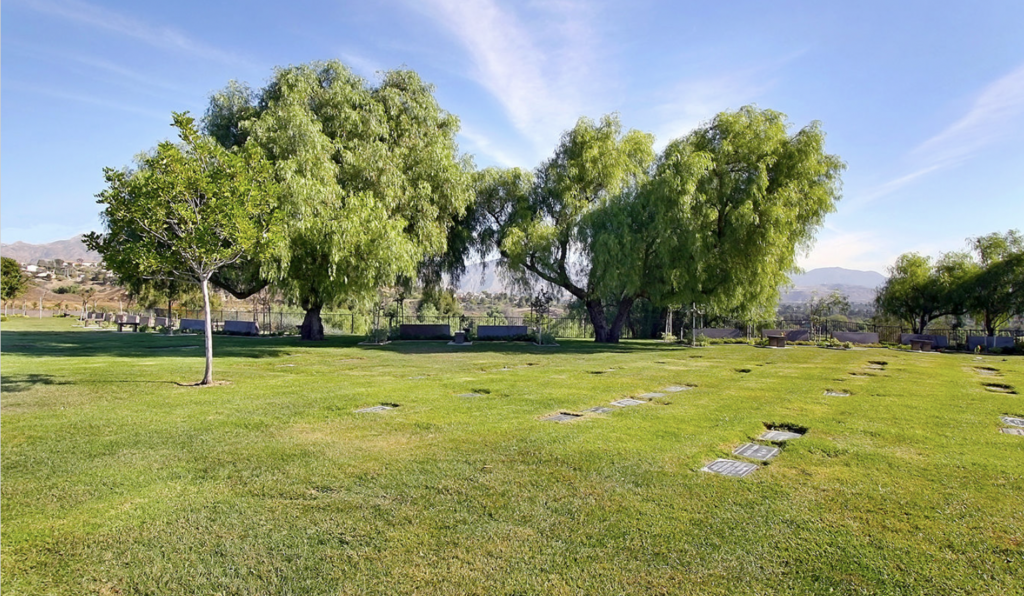California Jews, enough with your green, grassy Jewish cemeteries
In a megadrought, there’s better choices than lawn-covered graves

Graphic by Angelie Zaslavsky
Jewish law has a lot to say about what’s supposed to happen when you die: your lifeless body must be washed and buried quickly, with a simple headstone to mark your grave.
But nowhere, in 4,000 years of Jewish law, custom or tradition does it say you need to rest eternally under bright, green grass.
As California struggles with the West’s longest megadrought in 1,200 years, emergency water conservation rules are set to take effect on June 1. Yet cemeteries in Los Angeles, including the three largest Jewish ones, remain as grassy and green as a Scottish golf course.
It’s not a good look. If there’s a way to model the Jewish value of safeguarding creation, acres of green grass during a historic drought isn’t it. The two Mount Sinai Memorial Parks, Eden Memorial Park and Hillside Memorial Park are all visible from nearby freeways to tens of thousands of people each day. Isn’t it time these institutions set an example by converting to drought-tolerant native landscaping?
The cemeteries themselves would not provide figures on water usage, and at least one, Mount Sinai, uses reclaimed water. But these lawns are thirsty: The country’s largest cemetery, 700-acre Rose Hills Memorial Park in Glendale, was using 293 million gallons of potable water a year, enough to supply several cities, before it switched to reclaimed water in 2015.
So what will it take for L.A.’s Jewish cemeteries to go green?
The problem, it turns out, isn’t the cemeteries themselves — it’s their customers. When cemeteries push for ways to go green by going brown, they get pushback from clients who expect to spend eternity under a grassy knoll.
“I don’t think we’re there yet,” said Randy Schwab, the chief executive officer of Mount Sinai Memorial Park, as we stood facing a hill which covered the dearly departed with 6 feet of well-watered sod. “I don’t think our clients are quite there yet.”
Schwab and Kimber Sax, Mount Sinai’s advanced planning director — and a longtime friend — were walking me through a new, unfinished section of the cemetery’s Simi Valley location earlier this week. The area is mostly dirt now, but when it’s completed later this year, it will feature drought-tolerant grass, plants and trees, walls made of stacked local rocks, slate-like headstones and benches of reclaimed wood. Mature olive and Chinese pistache trees shade the site, which overlooks a natural ravine thick with wild vegetation. The sage scent of artemisia hangs in the air.
The natural burial area will use 35-40% less water than the traditional grassy area, said Schwab.
Burials in this new section, which is designed to hold 225 bodies, will not use concrete vaults, which keep lawns level as caskets degrade. Even caskets themselves will be optional: You could choose to go down covered in just a shawl, Israeli style, or pick out a quickly biodegradable $2,000 willow and seagrass casket.
(When Sax showed me a sample woven casket later, I said it had a vague Pier 1 vibe. “No, it’s like Baby Moses!” she said.)
The rest of the cemetery looks like what you’re probably used to seeing: smooth green lawn interrupted by bands of asphalt. While the cemetery’s original Hollywood Hills location uses reclaimed city water, Schwab said the Simi Valley location does not have access to reclaimed water.

Over the hills in West Los Angeles, Hillside Memorial Park, which is affiliated with Temple Israel of Hollywood, created one of California’s first green burial sections in 2015. It holds 110 plots in a drought-tolerant landscape.
But it’s not all eco-friendly: the 43-acre site also features a landmark 120-foot-long, five-tier cascading fountain marking the late show business icon Al Jolson’s tomb, and the management declined to specify whether the water it uses is reclaimed or potable. So did Eden Memorial Park, a Jewish cemetery at the far north end of the San Fernando Valley.
The new regulations from L.A.’s Department of Water and Power will limit private and commercial lawn watering to two days each week, but reclaimed water use will not be restricted. But using even reclaimed or recycled water begs the question: Why? Is keeping graves green the best use of that limited resource?
“Recycled water from a green burial standpoint would not be consistent with our philosophy,” said Jeff Hodes, a board member of the Green Burial Council, an industry group that promotes standards for environmentally sound burial practices. “It’s not first-generation water. It’s not rain.”
There are plenty of models for doing better: The 22-acre Mt. Sinai Cemetery in Phoenix covers graves in crushed granite, with cactus, rocks and desert shrubs in between. Cemeteries in Israel are lawn-less. Har HaMenuchot, Jerusalem’s largest cemetery, is a sea of stone and rock.
Here in California, the divide over a more climate-friendly cemetery may be generational. Mount Sinai held an open house for prospective advance planning customers May 15, and Sax said the younger visitors have warmed to the idea of less water-intensive natural cemetery grounds.
“This young man said, ‘That’s all I’m interested in,’” Sax told me. “The whole idea is, return to the earth.”
Mount Sinai and other final stops are preparing for future generations that will likely be as appalled by green lawns in 104-degree summers as past generations were comforted by them.
Schwab said Mount Sinai is in the process of replacing its 25-year-old outdated sprinkler system with a $500,000 one that adjusts water volume depending on humidity and location, projected to cut water usage by 20%. The large entrance fountain was replaced with more drought-tolerant landscaping as well.
Mount Sinai, in short, is doing its part. But it is still beholden to a customer base that expects to rest for eternity under grass, and that deeply held and unsustainable desire is not just a cemetery’s job to reverse.
The state faces a far drier future. Policy choices and trade-offs will only get tougher: Should we release water to save the wild salmon run? Or should we send that water to save farmland and slake the thirst of parched Central Valley communities? Should we build billion-dollar desalination plants? Or spend less but work harder to reclaim used water and capture natural rainfall?
As Californians face these hard decisions, California’s Jews can make an easy one. We can set a very public example: Stop pouring water on top of the dead, and save that precious resource for the living.
















